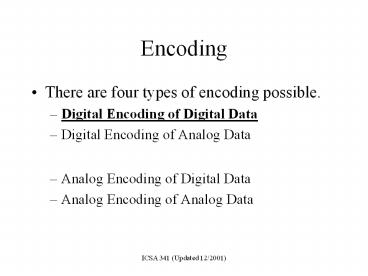Encoding - PowerPoint PPT Presentation
Title:
Encoding
Description:
Midbit transition is only for clocking. Transition at beginning of bit period=0. Transition absent at beginning=1. Has added advantage of differential encoding ... – PowerPoint PPT presentation
Number of Views:141
Avg rating:3.0/5.0
Title: Encoding
1
Encoding
- There are four types of encoding possible.
- Digital Encoding of Digital Data
- Digital Encoding of Analog Data
- Analog Encoding of Digital Data
- Analog Encoding of Analog Data
2
Digital Encoding of Digital Data
Digital Data of 0s and 1s
Digital Encoding Schemes
Polar
Unipolar
Bipolar
3
Unipolar Encoding
Unipolar Single voltage - one value
Zero voltage another value
AMPLITUDE
V
0 V
TIME
UNIPOLAR (positive voltage 1 zero voltage 0)
4
Polar Encoding Schemes
POLAR
RZ
NRZ
BIPHASE
DifferentialManchester
NRZ-L
NRZ-I
Manchester
5
0
0
0
0
1
1
1
0
1
AMPLITUDE
V
0 V
- V
TIME
POLAR NRZ-L (positive voltage 0 negative
voltage 1)
6
1
1
1
1
0
0
0
1
0
AMPLITUDE
V
0 V
- V
TIME
POLAR NRZ-I (change if next bit is a 1)
7
1
1
1
1
0
0
0
1
0
AMPLITUDE
V
0 V
- V
TIME
POLAR RZ (basically NRZ-L with return to zero at
midbit)
8
Manchester Code
- Transition in the middle of each bit period
- Transition provides clocking and data
- Low-to-high1, high-to-low0
- Used in Ethernet
9
1
1
1
1
0
0
0
1
0
AMPLITUDE
V
0 V
- V
TIME
BI-PHASE Manchester - shift to opposite pole at
midbit
(neg-to-pos 1 while a pos-to-neg 0)
10
Differential Manchester
- Midbit transition is only for clocking
- Transition at beginning of bit period0
- Transition absent at beginning1
- Has added advantage of differential encoding
- Used in token-ring
11
1
1
1
1
0
0
0
1
0
AMPLITUDE
V
0 V
- V
TIME
BI-PHASE Differential Manchester - shift to
opposite pole at midbit
(transition 0 and no transition 1)
12
Bipolar Encoding Schemes
BIPOLAR
AMI
HDB3
B8ZS
AMI - Alternate Mark Inversion B8ZS - Bipolar 8
Zero Substitution (North America) HDB3 - High
Density Bipolar 3 (Europe Japan)
13
Encoding
- Digital Encoding of Digital Data
- Digital Encoding of Analog Data
- Analog Encoding of Digital Data
- Analog Encoding of Analog Data
14
Analog to Digital Encoding
- Pulse Amplitude Modulation (PAM)
- sample analog signal (measure amplitude of signal
at equal intervals) - uses sample and hold technique
- generate pulses based on sampling
- First step in PCM - Pulse Code Modulation
- Quantize PAM Pulse - assign an integral value in
a specific range to sampled instances.
15
Sampling Rate
- How much should you sample?
- The sampling theorem (Nyquist Theorem) If a
signal is sampled at regular intervals of time
and at a rate higher at least twice the
significant signal frequency, the samples contain
sufficient information to ensure accurate
reproduce of the original signal. - 8000 samples/sec sufficient for 4000hz
16
Encoding
- Digital Encoding of Digital Data
- Digital Encoding of Analog Data
- Analog Encoding of Digital Data
- Analog Encoding of Analog Data
17
Analog Encoding of Digital Data
- Bit Rate - The number of bits transmitted in 1
second - Baud Rate - The number of signal units per second
required to represent those bits - Baud rate is less than or equal to bit rate
- Carrier Signal ?
18
Methods of Modulation
- amplitude shift keying (ASK)
- frequency shift keying (FSK)
- phase shift keying (PSK)
- differential phase shift keying(DPSK)
- quadrature amplitude modulation (QAM)
19
ASK Illustration
0
0
1
1
20
FSK Illustration
1
1
0
1
21
PSK Illustration
0
0
1
1
22
Complex Modulations
- Combining modulation techniques allows us to
transmit multiple bit values per signal change
(baud) - Increases information-carrying capacity of a
channel without increasing bandwidth - Increased combinations also leads to increased
likelihood of errors - Typically, amplitude and phase modulation are
combined
23
Quadrature Amplitude Modulation (QAM)
- the most common method for quadbit transfer
- combination of 8 different angles in phase
modulation and two amplitudes of signal - provides 16 different signals, each of which can
represent 4 bits
24
Quadrature Amplitude Modulation Illustration
90
135
45
amplitude 1
0
180
amplitude 2
225
315
270
25
Bit Baud Rate Comparison
26
Encoding
- Digital Encoding of Digital Data
- Digital Encoding of Analog Data
- Analog Encoding of Digital Data
- Analog Encoding of Analog Data
27
Methods of Modulation
- amplitude modulation (AM)
- frequency modulation (FM)
- phase modulation (PM)
28
Codec
- Coder/Decoder
- converts analog signals into a digital form and
- converts back digital data to analog signals
- e.g., hi-fi music, television pictures, the
output of copying machine, videoconferencing































